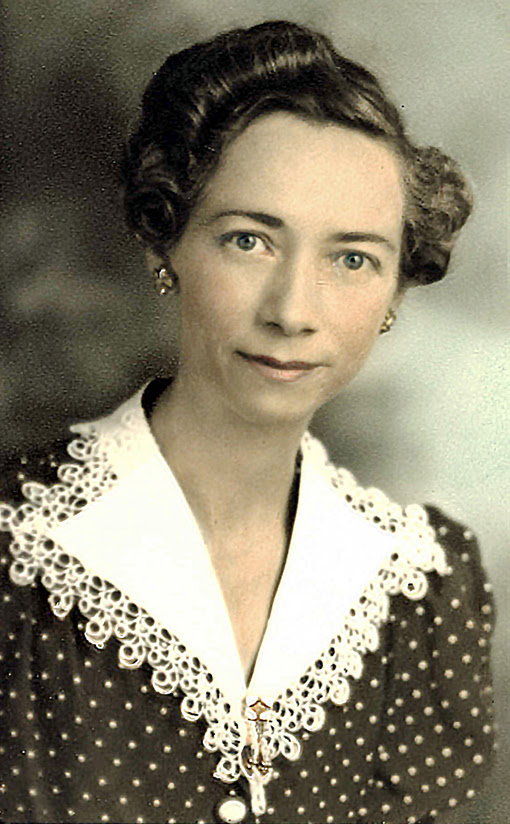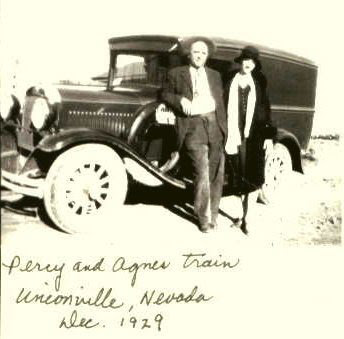She was a woman very much ahead of her time. A talented artist, author, botanist, and fossil collector, Agnes Train served as the first curator of the Nevada State Museum in 1941. And oh yes, from 1939 to 1956, she was also the owner of Genoa’s Pink House (with husband Percy), and was instrumental in preserving this landmark’s history and contents.
Despite all that, few folks have ever heard of Agnes Train. This wonderful guest blog about Agnes is written for you by Gail Allen, curator at Douglas County Historical Society and Museum. We’re so excited to share this exciting story about such an amazing and little-known woman. Hope you’ll stop in at the Museum soon to learn even more!
______________
Agnes Hume Scott was born in Seattle on March 24, 1905, to Margaret Hume and Walter John Scott. The family later moved to Chicago, where Agnes attended school. Her high school yearbook from 1924 shows her with a nickname of “Scotty.” Her interests at the time included art-related activities, with plans to become an “Artist Extraordinary.”
After high school, Agnes began working as a librarian in the Chicago Public Library. It was a fortuitous post, giving her skills and training she would use throughout her future life.

Using her earnings to buy two train tickets, Agnes traveled in 1926 with her mother to Seattle, to tour the area of her birth. And here fate intervened. She chanced to meet Percy Train aboard the train — a renowned fossil hunter, archeologist, mining engineer, and field representative of the Smithsonian Institute. After this chance encounter, the pair kept up a long-distance correspondence for over a year. Much to the amusement of Agnes’ co-workers Percy mailed her oddities from his travels, including a sheep fleece rolled up in a gunnysack and a dead black tarantula.
On June 7, 1928, Agnes and Percy hiked up Lone Mountain near Lovelock, where they were married at sunrise. She was 23; he was 52. They would spend much of the next eleven years together collecting fossils, minerals and plants together in the remote reaches of Nevada. Agnes used her artistic talent to sketch the specimens, and they were sent to museums across the country.

In 1937, the Trains joined a statewide project to identify and collect Nevada native plants. As part of this project, the couple interviewed of tribal members about the medicinal and other traditional uses of native plants. The results of their research were published in 1941 in a major work titled “Medicinal Uses of Plants by Indian Tribes of Nevada,” by Percy Train, et al. This groundbreaking study unexpectedly led to a breakthrough discovery in 1942 by the University of Minnesota’s pharmacological research team that helped preserve food rations in the Pacific during World War II.

In April 1939, the Trains purchased the “Pink House” in Genoa with all of the Virgin/Finnegan family possessions. They lovingly preserved the furniture, clothing, housewares, trunks, saddle, papers, books, portraits and records, and also restored the house to its original pink color.
In 1941, Agnes began volunteering at the not-yet-opened Nevada State Museum. The Chairman of the Museum Board, Judge Clark J. Guild, tasked her with unpacking “pioneer treasured items brought to the Museum on loan from Carson Valley ranches.” These had been left stacked in the basement in unopened boxes since the Museum office staff thought they were too “folksy.” Six weeks later, Agnes was offered the position of Museum Curator.
This achievement was marred by the sudden death of her husband, Percy, less than two months later. But Agnes continued her work. She became a tireless promoter of the museum, writing articles and speaking to community organizations about Nevada history, museum collections and the Trains’ work. Her librarian skills proved invaluable for cataloging Nevada fossil, plant specimens, and managing the Museum’s collections.

Agnes left Nevada in June 1944 after marrying John Janssen. The Janssens were dairy farmers, land developers, and cattle ranchers in California. The couple eventually retired to Salem, Oregon, where Agnes resumed her career as a librarian. Agnes continued to own the Pink House until 1956, where her parents lived and acted as caretakers of the residence and its contents. She sold the home after her widowed mother moved to Oregon.
In 1951, Agnes began to take actions to preserve both the Percy Train collections of fossils, minerals and flowers and the Pink House artifacts. Collections of historical items were donated to Mormon Station State Park, the Nevada State Historical Society, and Carson Valley Historical Society, now Douglas County Historical Society. In a letter to the Nevada State Historical Society, Agnes explained she wanted to “place various collections where the public will have access to them for research and reference.”
In 1977, Agnes published a book of recollections, “Nevada through Rose Colored Glasses.” This is a story of her Nevada life with Percy Train.
Agnes spent the last two years of her life in Carson City. She died on July 17, 1991 at age 86, and was buried next to her beloved Percy in Genoa Cemetery. His headstone reads: “Geologist . . . Botanist,” and hers: “Librarian . . . Curator.”
_______________
Written by Gail Allen, Curator of Douglas County Historical Society & Museum. Based on the story and background research was provided by Debbe Nye. Many thanks to both Gail and Debbe for sharing this wonderful information about the amazing Agnes Train! Featured photo (at top), showing the Trains all packed up for a collecting trip (with dog and chicken!) is courtesy of the wonderful Douglas County Historical Society & Museum.
